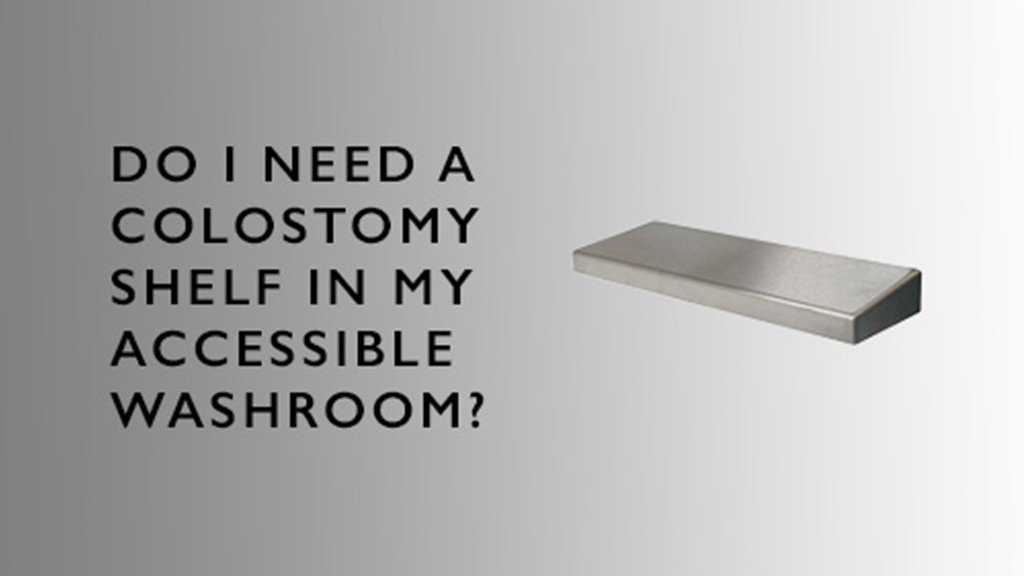21 June 2023
Reading time: 4 minutes
Architects and designers often face the challenge of determining whether to include a colostomy shelf and a general use shelf in an accessible washroom.
As a commercial washroom specialist in supplying washroom products, including the Dolphin shelf range, and providing accessible washroom solutions, we can help to explain whether you need colostomy shelves and general use shelves in your unisex accessible toilets or not.
In this blog, we will explore the regulations and British Standards regarding general use and colostomy shelves in a unisex accessible toilet, examine the recommended dimensions for both of these shelves, and discuss the importance of including shelving in accessible washrooms.
Watch our video below:

Contact the team or visit our learning hub to find out more.
Do you need shelving in a unisex accessible toilet?

Document Part M shelf guidelines
Approved Document Part M of the UK Building Regulations does not explicitly address the inclusion of a shelf in a unisex accessible toilet. However, it does furnish comprehensive diagrams outlining the minimum dimensions, heights, and arrangements of fittings within a corner WC accessible washroom, which notably incorporates a depiction of a colostomy shelf and a general use shelf.
Doc M also states that more guidance on appropriate sanitary and other fittings is given in BS8300-2:2018 in detail.
BS8300 shelf guidelines
What British Standards BS8300 tells us in Clause 18 is that convenient shelves are essential for individuals to store their personal belongings in sanitary accommodations. Therefore, it is crucial to ensure that proper provisions are made for these fittings.
The diagrams presented in BS8300 indicate the location of an accessible shelf, although they may sometimes be omitted due to the limited space available on the document page. Nevertheless, it is important to prioritise the provision of a colostomy shelf and general use shelf while ensuring they do not infringe on the manoeuvring spaces nor hinder access to or use of the essential washroom features.
Shelf dimensions in an accessible washroom

Colostomy shelf height and other dimensions
A colostomy shelf with dimensions of 250 mm width × 150 mm depth, positioned at a height of 950 mm above the finished floor level, is deemed appropriate for accommodating a colostomy bag. This colostomy shelf is suitable over a high or low level or reduced flush cistern.
However, if the cistern is close coupled, its top surface can serve the same purpose as a colostomy shelf for standing users, as long as the cistern surface is flat. Therefore, a colostomy shelf would not be necessary to install.

General use shelf dimensions
A general use shelf with dimensions of 400 mm width × 200 mm depth, positioned at a height of 760 mm above the finished floor level, is suitable for general use.
Shelf dimensions in an accessible washroom
The diagrams below illustrate a general guideline of two types of WC pans (close coupled and surface mounted with a concealed cistern), as well as a washbasin and related accessories. These diagrams focus on the recommended positions for a colostomy shelf and a general use shelf within a unisex accessible washroom.

Unisex wheelchair-accessible toilet with corner WC
Concealed cistern
- General use shelf at 760 mm above finished floor level, 400 mm width × 200 mm depth.
- Zone for colostomy shelf. 950 mm above the finished floor level, 250 mm width × 150 mm depth.
Remember: If the WC pan has a high or low level or reduced flush cistern, it should be accompanied by a rail with a padded backrest and a separate colostomy bag shelf should be provided. The colostomy shelf can be placed on the wall adjacent to the WC or on the back wall of the WC.

Unisex accessible toilet with corner WC layout
Close Coupled WC
- General use shelf at 760 mm above finished floor level, 400 mm width × 200 mm depth.
- The close coupled cistern provides both a back rest function and a colostomy bag changing surface function for standing users, as long as the cistern surface is flat.
Learn more about accessible washroom dimensions for unisex toilets.

Why should you include shelving in accessible washrooms?
Installing a colostomy shelf in addition to a general use shelf enhances the overall experience and functionality of a wheelchair washroom. It provides a practical storage solution, allowing individuals to keep their personal items within reach and allowing individuals in wheelchairs to maintain their independence and easily access their belongings.
From our experience, some designers have decided to include a colostomy shelf even if they have a close coupled cistern with a flat surface.
The general use shelf guidelines in BS8300 also align with the recommendations of The Good Loo Design, which suggest having a shelf next to the washbasin to accommodate items or handbags. This is particularly beneficial for individuals with hand or mobility impairments, and it helps keep their personal belongings off a potentially wet floor.

Enhancing accessibility with Doc M shelving
The inclusion of shelving in accessible washrooms plays a crucial role in enhancing functionality and providing convenience for individuals who use these facilities.
Document Part M of the UK Building Regulations provides comprehensive diagrams within the regulations to indicate the significance, dimensions, and proposed placements of a colostomy shelf and a general use shelf.
British Standards BS8300 further emphasise the importance of an accessible shelf and recommend providing shelving that adheres to specific dimensions based on the shelf’s purpose. This ensures practicality and accessibility within the wheelchair washroom.
Therefore, we can conclude that yes, both a general use shelf and a colostomy shelf should be included in a unisex accessible washroom, however, if the WC pan is close coupled with a flat surface cistern, then it is not necessary to install a colostomy shelf.
By including shelving, architects can create unisex wheelchair accessible washroom that prioritises user comfort and independence and demonstrates that their needs have been considered and accommodated.




